| The Cordoba
area of Argentina is one of the last frontiers for exceptional hunting.
Those of you that have been to Cordoba know of what I am about to
describe. Those of you that donít know may find this of interest.
Clay, my 16 year old son, Steve Friedman, and Steveís
son-in-law, Michael, left Houston on Saturday, March 9th at 5:30 p.m.
arriving in Miami at 8:30 local time. As luck would have it my suitcase
with my chokes, clothes, tools and gun parts never arrived on the baggage
carousel. We departed Miami to Santiago, Chile at 9:30 p.m. My bag stayed
in sunny Florida. We arrived in Santiago, Chile at 7:30 a.m. local time,
transferred to an 8:30 a.m. flight to Cordoba, arriving 9:30 a.m. We were
met by one of the family members of the Estancia who helped us get our
guns and luggage through customs. We finally arrived at the Estancia after
a one and a half hour drive.
Serge Dompierre is a former resident of Montreal. He was
an avid and competitive sporting clays shooter plus a world wide bird
hunter. Two years ago he purchased 4,000 acres and built his beautiful
estancia. The estancia is spotlessly clean, exquisitely appointed, and is
everything one could possibly want in a hunting lodge. This is his first
season and he has had 150 shooters, a fraction of what some of the other
outfitters will host in a year. This will surely change as more shooters
learn of his operation. Cordobaís dove population is between 20 and 40
million. Estancia Los Chanares has an estimated 10 million on the
property.
Serge has purchased land that once was used by other
outfitters and he cultivates various crops that hold the doves on the
property. Most other outfitters have to take their hunters on daily trips
to leased property, sometimes an hourís drive away from their estancia. At
Los Chanares our first four hunts were within walking distance of the
estancia. Never hunting the same spot twice we shot over a variety of
geography. Being an avid bird hunter, Serge shot with us every day and
tailored the difficulty of the shooting to our desires. A typical day of
shooting would start with breakfast, followed by our first hunt, back for
lunch, then the 2nd hunt of the day, back for dinner, ending with lounging
around discussing the dayís events.
|
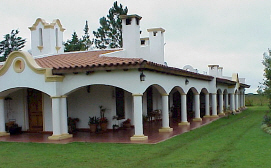
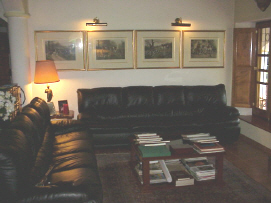
We'd sink into these couches after a day of
shooting
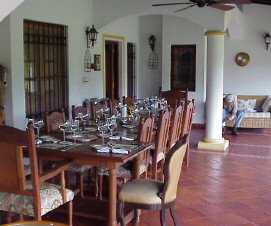

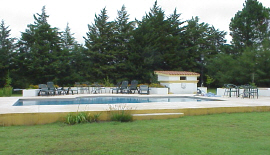
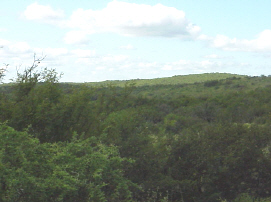
Typical lush hillside terrain
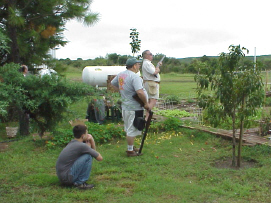
Shooting in the "back yard"
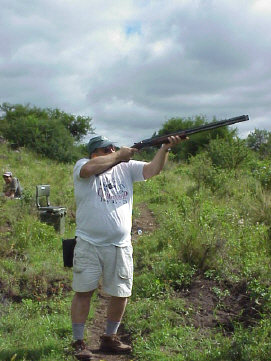
Can fatman shoot or what?!
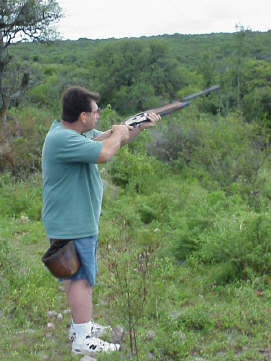
Notice how gun is moved away from bruised
shoulder!
|
Now, how many birds did we kill? Picture this. You stand at the edge of
the field with birds flying non-stop in every direction. Clay and I shot
most hunts side by side counting birds as we made clean kills. Clay is not
a "shooter", but on his second hunt counted 180 birds for himself alone.
We typically would shoot non stop for about two hours, only taking a drink
of water when needed and loading the autos as fast as we could. Blistered
fingers from loading shells, burned hands from touching the barrel, and
bruised shoulders were the badges we earned from shooting 260 boxes of
shells, 6,500 shots in six hunts....and we quite shooting before most of
the others, walking back early to the estancia! How many total did we
shoot? I donít know, but it would be in the thousands.
We wondered how long will shooting like this last in
Cordoba. According to Serge the doves nest five times during the course of
a year. Twenty to 40 million doves nesting five times, each time laying
two to three eggs adds up to a lot of new doves each year. The kill from
hunters is miniscule. The wild card in this scenario is the farmers of the
area consider doves a pest. Consuming 20% of the farmersí crops, the doves
strip farmersí fields in days. The farmers fight back by spraying poison
on the fields from airplanes. Serge is hopeful that the hunting will last
forever, however he says there is no way of knowing what effect the
spraying is having on the population.
Serge and his people made us all feel at home and
catered to our every need. Several of the other guests who had been to
other estancias said it doesnít get any better than this. If any of you
are interested in going there, feel free to
email Cindy and I will give you all
the particulars.
[by Joseph Barton] |